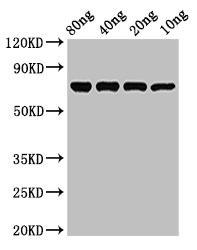Description
| Antibody Name: | NP Antibody (PACO53782) |
| Antibody SKU: | PACO53782 |
| Size: | 50ug |
| Host Species: | Rabbit |
| Tested Applications: | ELISA, WB |
| Recommended Dilutions: | ELISA:1:2000-1:10000, WB:1:500-1:5000 |
| Species Reactivity: | Influenza A virus |
| Immunogen: | Recombinant Influenza A virus Nucleoprotein protein (1-498AA) |
| Form: | Liquid |
| Storage Buffer: | Preservative: 0.03% Proclin 300 Constituents: 50% Glycerol, 0.01M PBS, pH 7.4 |
| Purification Method: | >95%, Protein G purified |
| Clonality: | Polyclonal |
| Isotype: | IgG |
| Conjugate: | Non-conjugated |
 | Western Blot. Positive WB detected in Recombinant protein. All lanes: NP antibody at 3µg/ml. Secondary. Goat polyclonal to rabbit IgG at 1/50000 dilution. Predicted band size: 71 kDa. Observed band size: 71 kDa. |
| Background: | Encapsidates the negative strand viral RNA, protecting it from nucleases. The encapsidated genomic RNA is termed the ribonucleoprotein (RNP) and serves as template for transcription and replication. The RNP needs to be localized in the nucleus to start an infectious cycle, but is too large to diffuse through the nuclear pore complex. NP comprises at least 2 nuclear localization signals and is responsible of the active RNP import into the nucleus through the cellular importin alpha/β pathway. Later in the infection, nucleus export of RNP are mediated through viral proteins NEP interacting with M1 which binds nucleoproteins. It is possible that the nucleoprotein binds directly exportin-1 (XPO1) and plays an active role in RNP nuclear export. M1 interaction with RNP seems to hide nucleoprotein's nuclear localization signals. Soon after a virion infects a new cell, M1 dissociates from the RNP under acid, fication of the virion driven by M2 protein. Dissociation of M1 from RNP unmask nucleoprotein's nuclear localization signals, targeting the RNP to the nucleus (By similarity). |
| Synonyms: | Nucleoprotein (Nucleocapsid protein) (Protein N), NP |
| UniProt Protein Function: | Encapsidates the negative strand viral RNA, protecting it from nucleases. The encapsidated genomic RNA is termed the ribonucleoprotein (RNP) and serves as template for transcription and replication. The RNP needs to be localized in the host nucleus to start an infectious cycle, but is too large to diffuse through the nuclear pore complex. NP comprises at least 2 nuclear localization signals that are responsible for the active RNP import into the nucleus through cellular importin alpha/beta pathway. Later in the infection, nclear export of RNPs are mediated through viral proteins NEP interacting with M1 which binds nucleoproteins. It is possible that nucleoprotein binds directly host exportin-1/XPO1 and plays an active role in RNPs nuclear export. M1 interaction with RNP seems to hide nucleoprotein's nuclear localization signals. Soon after a virion infects a new cell, M1 dissociates from the RNP under acidification of the virion driven by M2 protein. Dissociation of M1 from RNP unmasks nucleoprotein's nuclear localization signals, targeting the RNP to the nucleus. |
| UniProt Protein Details: | |
| NCBI Summary: | |
| UniProt Code: | P15682 |
| NCBI GenInfo Identifier: | 139091 |
| NCBI Gene ID: | |
| NCBI Accession: | P15682.1 |
| UniProt Secondary Accession: | P15682 |
| UniProt Related Accession: | P15682 |
| Molecular Weight: | 56,244 Da |
| NCBI Full Name: | Nucleoprotein |
| NCBI Synonym Full Names: | |
| NCBI Official Symbol: | |
| NCBI Official Synonym Symbols: | |
| NCBI Protein Information: | |
| UniProt Protein Name: | Nucleoprotein |
| UniProt Synonym Protein Names: | Nucleocapsid protein |
| Protein Family: | Nucleoprotein |
| UniProt Gene Name: | NP |
| UniProt Entry Name: |






